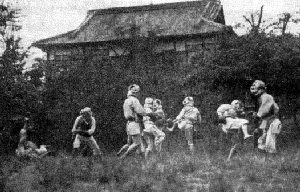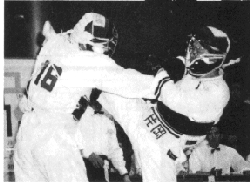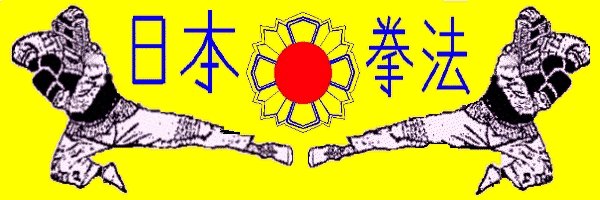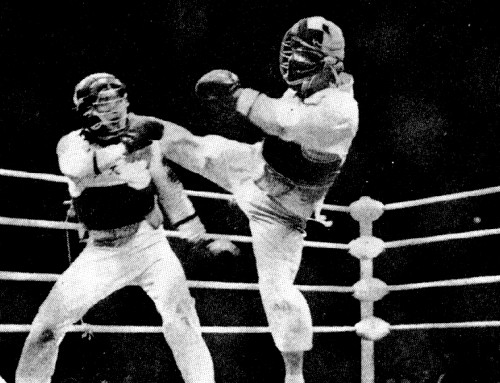| The history of the kempo japanese
The kempo is a technique of struggle to nude hands, that one resolves to fight the adversary with techniques like
the " ATEMI-WAZA " that it uses of the fist and of the foot for push, strike and to kick the adversary, the
" NAGE-WAZA " that it is used when it is come grabbed, the " KANSETSU GYAKUTORI WAZA ".
We will illustrate this discipline following the history from Japan.
If we go to seek the origins of the Nihon kenpo, arrive to the same source of the Sumo and of the Judo: the
competition of force among two of the Takemikazuchi god (to which it is consecrated the Kashima sanctuary), and
the Takemikata god ( to which it has devoted the big sanctuary of Suwa ).
It is locate in the part dedicated to the " cession of the country " in the " memories of the
ancients events."
TheTakemikazuchi god seizures the arm of theTakemikata god and, is said
" like if it eradicates of the new grass, grabbed it, twisted it and the hurl by " for which it could be
thought to an example of " Kansetsu Gyakutori Waza " of the elbow.
According to the " Annals from Japan ", the seventh of the day of the seventh month of the
seventh year of the Suinin emperor, in the district of Shiki in the province of Yamato was carried out to the first
presence of the emperor the first meeting of Sumo.
Nomi-no-Kehaya, of the citizien of Taima in the province of Yamato, was particularly able in the use of the
kicks, therefore to its name it had added that one of Kehaya ( faster ).
But also the technique of attack of his Nomi-no-Sukune adversary, of the province of Izumo, it was the "Keri
waza."
The contenders one broke lose kicks to event; then Sukune arranged a kick to the mouth of the stomach of Kehaya
and put it KO.
Written is that then it treaded on it and broke it the backs, until to kill it.
Until they had then not been fixed rules on the place where they must unwind the meetings, but in the
" Period of the states in war " around the 1600 came unified the country; then, departed the
feudal period, it followed an age of disorders in which the martial arts they were a weapon for hurt and kill.
Finally it asserted the modern state, the peace returned, and since then the martial arts became the
" technique of daily training of the body and of the spirit for the soldiers ".
According to the " Chronicle of the origins of the schools of martial arts " the number of the
schools was 175, classified in seven groups: military science, art of the cast with the arc, horseback riding, art of the
sword, art of the lance, art of her arms from fire and Ju jitsu.
Until to today, the witnesses of martial arts and the books of history consider Jion, bronze of Kamakura, like
the founder of the martial arts in Japan.< br>
On the history and the organization, we will present an extract from
" NIHON KENPO ",
twentieth volume of the " Diagram of the physical education and of the contemporary sports "
published from the publishing house Kodansha the June 12 of 1984.
To the beginning of the age Showa, Kuroyama Takamaro, president of the committee of the Fire ( Fukuoka 1895-1977 ),
teacher of Judo to the quartier general of the police of the province of Osaka, that had studied to the Guardian Institute
of Martial arts of Kyoto ( to the fourth cycle from the foundation of the school ), had suffered a big disappointment
before the disappearance of the "Atemi no Waza", technique that one was hands down in the varied schools of Ju Jitsu.
As askes to Sawayama Masaru ( Muneomi, Osaka 1906-1977 ), student of the circle of Judo of the university of the
Kansai, to do rebirth the " Atemi no Waza " and to study sure methods of training.
Here the substance of the search:
For the " Atemi no Waza " it comes used much force. how prevent us the abuse ?
- In the traning presented themselves of the dangers, that until now they to have prevented to practice to
sufficiency. Must be required then of the sure techniques.
- How to render notes those techniques that the narrow mentality of the period in which they existed like martial
arts had prevented of disclose why secret ?
Those people that learns the Kempo they must have an adequate acquaintance of the vital points ( points of
attachment ) also "Atemi no waza " of the human body.
All the vital points must be protected from the armor" DO "
This because the victory or the defeat decides in base to the force and to the precision or imprecision of the hits.
The vital points are those leave births human body are vulnerabilities and sensitive to hits and external pressure.
If such points are struck with violence, they are carried out of taken ones or stranglings or pressure is made, instant
death could be caused, fainting fit, the acute pain, paralysis with temporary loss of force.
Additionally, one is struck the inside organs or the nerves, the damage doesn't reveal sudden but after any day.
There are many vital points in the human body.
Each man has but a strong instinct of inborn survival and it therefore very difficult arrange a precise hit in one of them.
In the Korkyu Jujutsu ( Jujutsu of the ancient school ) the anatomical scheme of the vital points of the human
body was a precious teaching and therefore it was held hidden.
The armor serves to protect the vital points of the body from the hits and consists of bodice, mask, shell, boxing
gloves and special shoes.
That the armor fits perfectly or minus, influences greatly on the struggle.
Systematize the mask well; it is essential that the gloves (oz.6) are well shod ( in contrary case a finger could be
dislocated us ).
It is not an exaggeration affirm that the pace with which a club progresses could be measured from the quality and
quantity of armors.
In fact, when the student progresses is necessary endow it of a better armor, it renders stronger and thank it to her
fight.
There is who call it " protectress of the life ", and if not has care of it is not ameliorated.
We prove to remember anything on the age of the foundation of the Japanese Kempo examining the principal lines of
the Kokakai, the dojo where it has borne, and flowing the chronicles of the antecedent activities to the second world
collision and those of bellic age .
The Kokakai had founded in the last year of the era " Taisho " ( 1926 ) but the age of the real and own
activity goes from the VII year of the era " Showa " ( 1932 ) year in which had founded the principal venue of
the Kempo in the province of Osaka, up to the XX year showa ( 1945 ), when this venue was destroyed from the
intense aerial bombardments.

The construction stretched on 130 tsubo (around m2 430), the dojo measured 57 of it (around m2 149); its for the age
was really awful.
The principal base of the activity was the bureau of Judo but the teacher Sawayama Masaru, that devoted itself to
the study of the atemi no waza of the old school " Korkyu atemi no waza ", it in the 1932 founded the bureau
of kempo also creating the " Dai Nippon Kenpokai ", it translates us of " the big Japan of
the kempo association ".
For cultivate the spirit founded besides a school that many young people picked up.
The purpose of the Judo and of the Kempo was to train the body and the spirit across the exercise and the training of
the Budo; the witticism was believe and obey to the concept of State - Family.
The first of the two ideogramms used for write Kempo " Ken ", if it try to consult a dictionary present the
principal meaning of " fist ", " force " it conduct us as to the most complex meaning of " Way of the Ken."
Essential is understand and remember that it of front to a difficulty is more important the wish that the acquaintance
of the things.
Don't fear to make a mistake, have the force to continue and be bold: here thing opens the by of the future.
|











